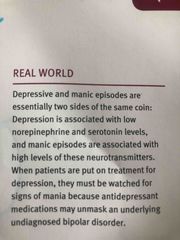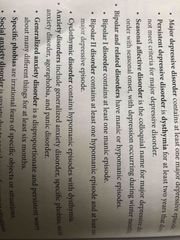![]()
![]()
![]()
Use LEFT and RIGHT arrow keys to navigate between flashcards;
Use UP and DOWN arrow keys to flip the card;
H to show hint;
A reads text to speech;
54 Cards in this Set
- Front
- Back
- 3rd side (hint)
|
This approach assumes that any disorder has roots in biomedical disturbances and thus the solution should also be of a biomedical nature. |
Biomedical Approach |
|
|
|
This method assumes that there are biological, psychological and social components to an individual’s disorder. |
Biopsychosocial Approach |
|
|
|
This kind of therapy aims to increase social support by educating and empowering family and friends of the affected individual. |
Indirect Therapy |
|
|
|
What is the opposite difference of Schizophrenia and Parkinson's Disease? |
Schizophrenia is associated with an excess of dopamine while Parkinson's disease is deficit in dopamine. |
|
|
|
Medications for Schizophrenia |
Neuroleptics - block dopamine receptors |
|
|
|
How would be the diagnosis of Schizophrenia? |
Atleast six months of continuous signs of disturbance and atleast one month of it is persisting active symptoms like dellusions, hallucinations and disorganized speech. |
|
|
|
What are the positive symptoms of Schizophrenia? |
Two Dimensions: Psychotic Dimension - Hallucinations and Dellusions Disorganized Dimension - disorganized thought and disorganized behavior |
|
|
|
What are the negative symptoms of Schizophrenia? |
Disturbance of Affect and Avolition |
|
|
|
These are false beliefs discordant with reality and not shared by others in the individual's culture that are maintained in spite of strong evidence to the contrary. |
Delusions |
|
|
|
The three types of delusions |
Delusions of reference, of persecution and of Grandeur |
|
|
|
The person believes that the characters in the television is talking to him directly. |
Delusions of Reference |
|
|
|
He or she believes that is remarkable in some significant way, such as being an actor, inventor, or religious icon |
Delusions of Grandeur |
|
|
|
What is delusion of persecution? |
He or she believes that he or she is being discriminated, threatened or plotted against. |
|
|
|
the belief that one's thought are broadcast directly from one's head to the external world |
thought broadcasting |
|
|
|
the belief that thoughts are being placed in one's head |
thought insertion |
|
|
|
these are perceptions that are not due to external stimuli but have a compelling sense of reality |
Hallucinations |
|
|
|
Which is the most common form of hallucinations? |
Auditory |
|
|
|
This is characterized by loosening of associations |
Disorganized Thought |
|
|
|
A patient's speech may be so disorganized that it seems to have no structure - as though it were just words thrown together incomprehensibly. |
Word Salad |
|
|
|
It refers to an inability to carry out activities of daily living, such as paying bills, maintaining hygiene and keeping appointments. |
Disorganized Behavior |
|
|
|
Refers to certain motor behaviors chracteristic of some people with schizophrenia |
CATATONIA |
|
|
|
echolalia and echopraxia |
repeating another's words and imitating another's actions |
|
|
|
It refers to the experience and display of emotion. |
Affect |
|
|
|
It states that schizophrenia causes a decline in SES leading to worsening symptoms, which sets up a negative spiral for the patient toward poverty and psychosis. |
Downward Drift Hypothesis |
|
|
|
This is marked by decreased engagement in purposeful, goal-directed actions |
Avolition |
|
|
|
Three types of affective symptoms of Schizophrenia |
Blunting, flat affect, and inappropriate affect |
|
|
|
This is exemplified by clear evidence of deterioration, social withdrawal, role functioning impairment, peculiar behavior, inappropriate affect and unusual experiences. |
Prodromal Phase |
|
|
|
Major Depressive disorder is a mood disorder characterized by at least one major depressive episode. So what is major depressive episode? |
It is a period of at least two weeks with at least five of the following symptoms: SIG E. CAPS. |
|
|
|
Symptoms of Major Depressive Disorder |
Sadness Sleep Interest Guilt Energy Concentration Appetite Psychomotor Symptoms Suicidal Thoughts |
|
|
|
A diagnosis of Persistent Depressive disorder is given to |
Dysthymia |
|
|
|
A depressed mood that isn't severe enough to meet the criteria of a major depressive episode, most of the time for at least two years. |
Dysthymia |
|
|
|
This disorder may be related to abnormal melatonin metabolism; it is often treated with bright light therapy, where the patient is exposed to a bright light for a specified amount of time each day. |
Seasonal Affective Disorder |
|
|
|
it is characterized by both depression and mania |
Bipolar Disorder |
|
|
|
Symptoms of Manic Episode |
Distractible Insomnia (Deccreased need of sleep) Grandiosity Flight of ideas (racing thoughts) Agitation Speech (increase talkativeness) Thoughtlessness (involvement to risky behavior) |
|
|
|
What would be the diagnosis of Bipolar Disorder? |
Elevated mood of atleast one week with atleast 3 symptoms seen |
|
|
|
This theory holds that too much nor epinephrine and serotonin in the synapse leads to mania, while too little leads to depression. |
Catecholamine Theory of Depression |
|
|
|
This disorder results in persistent fear when exposed to social or performance situations that may result in embarassment; for example, delivering a speech, socializing at a party or using a public restroom. |
Social Anxiety Disorder |
|
|
|
It is an anxiety disorder characterized by a fear of being in places or in situations where it might be hard for an individual to escape. |
Agoraphobia |
|
|
|
These are caused by excess activation of the sympathetic nervous system (autonomic drive) which leads to repettitive panic attacks. |
Panic Disorder |
|
|
|
Symptoms of Panic Attack |
Fear Apprehension Trembling Sweating Hyperventilation Sense of unreality |
FATSHS |
|
|
Why is dpressive disorder and manic episodes related? |

Back (Definition) |
|
|
|
Different types of bipolar disorder |

Back (Definition) |
|
|
|
How would be the diagnosis of PTSD? |
Particular number of symptoms are seen for atleast a month |
|
|
|
Diagnosis of acute stress disorder |
Symptoms of PTSD seen kess than a month but more than three days |
|
|
|
How would be the diagnosis of PTSD? |
Particular number of symptoms are seen for atleast a month |
|
|
|
Diagnosis of acute stress disorder |
Symptoms of PTSD seen kess than a month but more than three days |
|
|
|
Symptoms of PTSD |
Intrusion Negative Cognitive Arousal Avoidance |
INAA |
|
|
It is a sudden unexpected move or purposeless wandering away from one’s home or location of usual daily activities. |
Dissociative Fugue |
|
|
|
Individuals feell detached from theur own mind and body or from their surroundings. They also can’t recognize own’s reflection. |
Depersonalization or derealization disorder |
|
|
|
It is characterized by being consumed with thoughts about haveing or developing a serious medical condition. |
Illness Anxiety Disorder |
|
|
|
It is an inability to recall past experiences without an inderlying neurological disorder. |
Disaociative Amnesia |
|
|
|
It is characterized by an unrealistic negative evaluation of one’s appearance or a specific body part. |
Body Dysmorphic disorder |
|
|
|
Becoming blind after a traumatic event of a related individual but without neurological damage senn |
Conversion disorder |
|
|
|
A somatic symptom that is not explainable by medical conditon is causing disproportionate concern |
Somatic symptom disorder |
|

